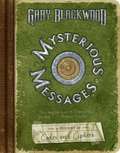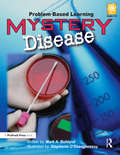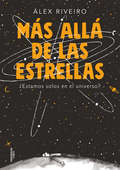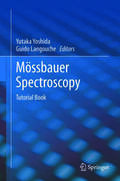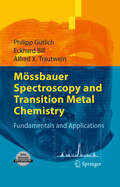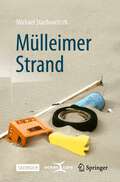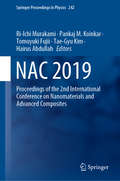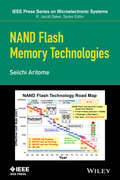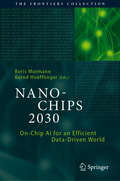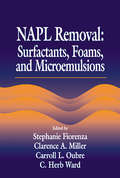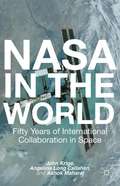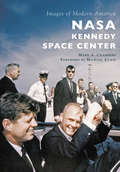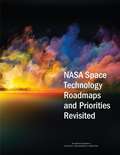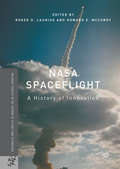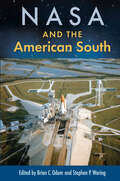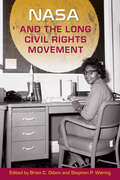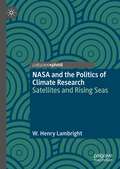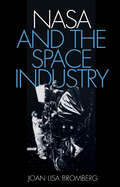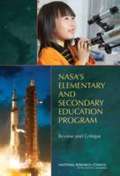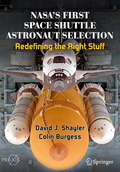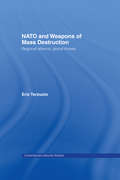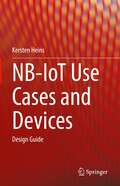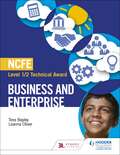- Table View
- List View
Mysterious Messages: A History of Codes and Ciphers
by Gary BlackwoodHistory?s amazing secrets and codes?and how to crack them yourself. This fascinating look at history?s most mysterious messages is packed with puzzles to decode and ciphers that kids can use themselves. Here are the encrypted notes of Spartan warriors, the brilliant code-crackers of Elizabeth I, secret messages of the American Revolution, spy books of the Civil War, the famous Enigma Machine, and the Navajo code talkers. As computers change the way we communicate, codes today are more intriguing than ever. From invisible ink to the CIA, this exciting trip through history is a hands-on, interactive experience? so get cracking!
Mystery Disease: Problem-Based Learning (Grades 5-8)
by Mark A. BohlandA serious illness is sweeping through town. Why are people getting sick? What is the source of this disease? With this problem-based learning unit, students become public health workers as they track down the source of a mysterious illness. Working in teams to solve the real-world problem and present their findings, they experience genuine, higher order learning. Decisions they make affect the outcome of the simulation.The activities combine science, social studies, math, research, thinking, cooperation, and speech skills in one great unit. This guide includes everything you need—teacher's directions and student information in the form of memos and medical reports.This open-ended scenario will draw students into a real-life drama.Allow your students to solve more real-life problems in Crime Scene Detective, Detective Club, Mystery Science, and The Great Chocolate Caper.Grades 5-8
Más allá de las estrellas: ¿Estamos solos en el universo?
by Álex Riveiro¿Hay vida en otros lugares del Sistema Solar? ¿Cuántas civilizaciones pueden existir en la galaxia? ¿Nos conoceremos algún día? Desde pequeños, nos fascinan las estrellas y los planetas. En seguida nos preguntamos si en su superficie podría haber criaturas, como tú y como yo, preguntándose si en otros lugares de la galaxia habrá seres como ellos... La avalancha de preguntas es imparable: el ser humano es curioso por naturaleza. Si alguna vez te has hecho alguna de estas preguntas, este libro es para ti. De la mano de Alex Riveiro, autor de Hacia las estrellas. Una breve guía del universo, y creador de Astrobitácora, el podcast de referencia de astronomía en español.
Mössbauer Spectroscopy
by Guido Langouche Yutaka YoshidaTutorials on Mössbauer Spectroscopy Since the discovery of the Mössbauer Effect many excellent books have been published for researchers and for doctoral and master level students. However, there appears to be no textbook available for final year bachelor students, nor for people working in industry who have received only basic courses in classical mechanics, electromagnetism, quantum mechanics, chemistry and materials science. The challenge of this book is to give an introduction to Mössbauer Spectroscopy for this level. The ultimate goal of this book is to give this audience not only a scientific introduction to the technique, but also to demonstrate in an attractive way the power of Mössbauer Spectroscopy in many fields of science, in order to create interest among the readers in joining the community of Mössbauer spectroscopists. This is particularly important at times where in many Mössbauer laboratories succession is at stake. This book will be used as a textbook for the tutorial sessions, organized at the occasion of the 2011 International Conference on the Application of Mössbauer Spectroscopy (ICAME2011) in Tokyo.
Mössbauer Spectroscopy and Transition Metal Chemistry
by Eckhard Bill Philipp Gütlich Alfred X. Trautweinconcentrates on teaching techniques using as much theory as needed.application of the techniques to many problems of materials characterization.Mössbauer spectroscopy is a profound analytical method which has nevertheless continued to develop. The authors now present a state-of-the art book which consists of two parts. The first part details the fundamentals of Mössbauer spectroscopy and is based on a book published in 1978 in the Springer series 'Inorganic Chemistry Concepts' by P. Gütlich, R. Link and A.X. Trautwein. The second part covers useful practical aspects of measurements, and the application of the techniques to many problems of materials characterization. The update includes the use of synchroton radiation and many instructive and illustrative examples in fields such as solid state chemistry, biology and physics, materials and the geosciences, as well as industrial applications. Special chapters on magnetic relaxation phenomena (S. Morup) and computation of hyperfine interaction parameters (F. Neese) are also included. The book concentrates on teaching the technique using theory as much as needed and as little as possible. The reader will learn the fundamentals of the technique and how to apply it to many problems of materials characterization. Transition metal chemistry, studied on the basis of the most widely used Mössbauer isotopes, will be in the foreground.
Mülleimer Strand
by Michael StachowitschDieses reich illustrierte Buch ist der ideale Führer zu den Gegenständen, die an den Stränden der Welt herumliegen. Vergessen Sie Muscheln und andere Fauna und Flora. Hier finden Sie, was ein Strandbesucher heutzutage am ehesten antreffen kann: Glas, Plastik, Holz, Metall, Papier, Öl und andere Quellen der Meeresverschmutzung!Mit fast 700 Fotos zeigt dieser Leitfaden die ganze Bandbreite der Müllgegenstände im Meer, die jeweils mit einem Augenzwinkern und einer Prise Humor vorgestellt werden. Darüber hinaus liefert der Autor ausführliche Informationen zu diesen Gegenständen. Sie werden alles Wissenswerte über sie erfahren. Dazu gehören nicht nur ihre Herkunft und ihre Zersetzungsstadien. Sie erfahren, welche Bedrohung die einzelnen Gegenstände für diese wunderschöne Umwelt darstellen, und erhalten Informationen über Präventionsstrategien, Empfehlungen für die Reinigung, alternative Produkte sowie Recycling- und Upcycling-Ideen. Neben dem ästhetischen Aspekt stellt der Müll im Meer auch eine Bedrohung für die Tierwelt, die menschliche Gesundheit und das wirtschaftliche Wohlergehen dar. Dieses Buch gibt Ihnen das nötige Wissen an die Hand, um diese schändlichen und oft gefährlichen Schandflecke zu bekämpfen. Werden Sie ein Stranddetektiv! Bereisen Sie mit dieser ultimativen Strandlektüre die beliebtesten Reiseziele der Welt und helfen Sie mit, diese faszinierenden Umgebungen in ihrer natürlichen Schönheit wiederherzustellen.
NAC 2019: Proceedings of the 2nd International Conference on Nanomaterials and Advanced Composites (Springer Proceedings in Physics #242)
by Ri-Ichi Murakami Pankaj M. Koinkar Tomoyuki Fujii Tae-Gyu Kim Hairus AbdullahThis book presents selected articles from the 2nd International Conference on Nanomaterials and Advanced Composites, which brings together leading researchers and professionals from academia and industry to present their findings and provides a platform for the exchange of ideas and future collaboration. The book covers eight topics, including nanomaterials, polymer materials, mechanical materials, materials chemistry, materials physics, ceramics, recycling materials and green composites.
NAND Flash Memory Technologies
by Seiichi AritomeThis book thoroughly describes basic and advanced NAND Flash memory technologies, including the principles of NAND flash, memory cell technologies, multi-bits cell technologies, scaling challenge of memory cell, reliability, and 3-dimensinal cell as the future technology.
NANO-CHIPS 2030: On-Chip AI for an Efficient Data-Driven World (The Frontiers Collection)
by Bernd Hoefflinger Boris MurmannIn this book, a global team of experts from academia, research institutes and industry presents their vision on how new nano-chip architectures will enable the performance and energy efficiency needed for AI-driven advancements in autonomous mobility, healthcare, and man-machine cooperation. Recent reviews of the status quo, as presented in CHIPS 2020 (Springer), have prompted the need for an urgent reassessment of opportunities in nanoelectronic information technology. As such, this book explores the foundations of a new era in nanoelectronics that will drive progress in intelligent chip systems for energy-efficient information technology, on-chip deep learning for data analytics, and quantum computing. Given its scope, this book provides a timely compendium that hopes to inspire and shape the future of nanoelectronics in the decades to come.
NAPL Removal Surfactants, Foams, and Microemulsions (AATDF Monograph Series)
by C. H. WardComplete and quantitative, NAPL Removal: Surfactants, Foams, and Microemulsions, belongs to a ten-monograph series that records the results of the Department of Defense/Advanced Applied Technology Demonstration Facility environmental technology demonstrations. It presents the outcome of field demonstrations of innovative in situ remediation technol
NASA IN THE World
by John Krige Angelina Long Callahan Ashok MaharajSince its inception, NASA has participated in over 4,000 international projects, yet historians have almost entirely neglected this remarkable aspect of the agency's work. This groundbreaking work is the first to trace NASA's history in a truly international context, drawing on unprecedented access to agency archives and personnel.
NASA Kennedy Space Center (Images of Modern America)
by Mark A. Chambers Michael CurieFrom Bumper V-2 rocket launches in 1950 to the launch of the Orion spacecraft atop a Delta IV rocket in 2014, NASA's Kennedy Space Center has served as the nation's portal to outer space for over 60 years. Images of Modern America: NASA Kennedy Space Center provides a fascinating look at the evolution of spacecraft technology and vintage images of Florida's scenic Merritt Island, known as the "Space Coast." This photographic history of the nation's premier spaceport looks back at the United States' glorious past in space exploration and ahead to its future.
NASA Space Technology Roadmaps and Priorities
by Steering Committee for NASA Technology RoadmapsNASA's Office of the Chief Technologist (OCT) has begun to rebuild the advanced space technology program in the agency with plans laid out in 14 draft technology roadmaps. It has been years since NASA has had a vigorous, broad-based program in advanced space technology development and its technology base has been largely depleted. However, success in executing future NASA space missions will depend on advanced technology developments that should already be underway. Reaching out to involve the external technical community, the National Research Council (NRC) considered the 14 draft technology roadmaps prepared by OCT and ranked the top technical challenges and highest priority technologies that NASA should emphasize in the next 5 years. This report provides specific guidance and recommendations on how the effectiveness of the technology development program managed by OCT can be enhanced in the face of scarce resources.
NASA Space Technology Roadmaps and Priorities Revisited
by Engineering Medicine National Academies of SciencesHistorically, the United States has been a world leader in aerospace endeavors in both the government and commercial sectors. A key factor in aerospace leadership is continuous development of advanced technology, which is critical to U.S. ambitions in space, including a human mission to Mars. To continue to achieve progress, NASA is currently executing a series of aeronautics and space technology programs using a roadmapping process to identify technology needs and improve the management of its technology development portfolio. NASA created a set of 14 draft technology roadmaps in 2010 to guide the development of space technologies. In 2015, NASA issued a revised set of roadmaps. A significant new aspect of the update has been the effort to assess the relevance of the technologies by listing the enabling and enhancing technologies for specific design reference missions (DRMs) from the Human Exploration and Operations Mission Directorate and the Science Mission Directorate. NASA Space Technology Roadmaps and Priorities Revisited prioritizes new technologies in the 2015 roadmaps and recommends a methodology for conducting independent reviews of future updates to NASA’s space technology roadmaps, which are expected to occur every 4 years.
NASA Spaceflight
by Roger D. Launius Howard E. MccurdyThis book presents the first comprehensive history of innovation at NASA, bringing together experts in the field to illuminate how public-private and international partnerships have fueled new ways of exploring space since the beginning of space travel itself. Twelve case studies trace the messy, risky history of such partnerships, exploring the role of AT&T in the early development of satellite technology, the connections between the Apollo program and Silicon Valley, the rise of SpaceX, and more. Some of these projects have succeeded, and some have failed; all have challenged conventional methods of doing the public's business in space. Together, these essays offer new insights into how innovation happens, with invaluable lessons for policymakers, investors, economists, and members of the space community.
NASA and the American South
by Brian C. Odom Stephen P. WaringAn unprecedented examination of NASA’s strong ties to the American South, exploring how the space program and the region have influenced each other over 60 years During the Cold War, federal funding for the space program transformed the southern United States as NASA built most of its major new facilities in the region and invested heavily in Project Apollo. This volume examines the economic, social, political, and cultural impacts of NASA on the South since the space program was founded in 1958 and explores how the program’s strong relationship to the region has affected NASA’s organizational culture, technological development, and programmatic goals.Featuring contributions by scholars from a range of backgrounds, including space historians and specialists in many other fields, NASA and the American South offers perspectives on how NASA provided a springboard for the complete restructuring of communities that were home to its facilities in Alabama, Florida, Mississippi, Louisiana, and Texas. These changes unsettled previous patterns of life, and the chapters in this volume include assessments of NASA’s influence on regional development, tourism, art and architecture, religion, and Black institutions of higher education.Bridging the gap between the history of technology and its geographical and cultural contexts, this book offers an unprecedented reevaluation of the impact of the space program on its surrounding landscape, introducing a new framework for interpreting the agency’s legacy. Contributors: Jennifer Ross-Nazzal | Dr Roger D. Launius | Professor Stephen P. Waring | Andrew J. Dunar | Emily A. Margolis | Douglas Brinkley | Rachael Kirschenmann | Caroline T. Swope | Jeffrey Nesbit | Stuart Simms | Kari Edwards | Max Campbell | Drew Adan | Brian C. Odom | Arslan Jumaniyazov | Katarzyna Balug
NASA and the Long Civil Rights Movement
by Brian C. Odom and Stephen P. WaringAmerican Astronautical Society Eugene M. Emme Astronautical Literature Award <p><p> As NASA prepared for the launch of Apollo 11 in July 1969, many African American leaders protested the billions of dollars used to fund “space joyrides” rather than help tackle poverty, inequality, and discrimination at home. This volume examines such tensions as well as the ways in which NASA’s goal of space exploration aligned with the cause of racial equality. It provides new insights into the complex relationship between the space program and the civil rights movement in the Jim Crow South and abroad. <p><p> Essays explore how thousands of jobs created during the space race offered new opportunities for minorities in places like Huntsville, Alabama, while at the same time segregation at NASA’s satellite tracking station in South Africa led to that facility’s closure. Other topics include black skepticism toward NASA’s framing of space exploration as “for the benefit of all mankind,” NASA’s track record in hiring women and minorities, and the efforts of black activists to increase minority access to education that would lead to greater participation in the space program. The volume also addresses how to best find and preserve archival evidence of African American contributions that are missing from narratives of space exploration. <p><p> NASA and the Long Civil Rights Movement offers important lessons from history as today’s activists grapple with the distance between social movements like Black Lives Matter and scientific ambitions such as NASA’s mission to Mars.
NASA and the Politics of Climate Research: Satellites and Rising Seas (Palgrave Studies in the History of Science and Technology)
by W. Henry LambrightToday, there exists an integrated, large-scale satellite system to track sea-level rise, its speed, causes, and impacts. Building it was a struggle every step of the way. It was the most vivid and potentially consequential program within NASA’s larger Earth Science directorate. How did it happen? Who did what? Why? This book seeks to answer such questions. It goes back to the origins of NASA’s interest in the oceans in the 1960s and first true ocean satellite, Seasat, in 1978. After three months of operation, Seasat failed. But before it did, it showed how much satellites could tell about the ocean’s dynamics. In many ways, sea-level rise is the clearest and most understandable result of a warming planet.
NASA and the Space Industry (New Series in NASA History)
by Joan Lisa BrombergFew federal agencies have more extensive ties to the private sector than NASA. NASA's relationships with its many aerospace industry suppliers of rocket engines, computers, electronics, gauges, valves, O-rings, and other materials have often been described as "partnerships." These have produced a few memorable catastrophes, but mostly technical achievements of the highest order. Until now, no one has written extensively about them.In NASA and the Space Industry, Joan Lisa Bromberg explores how NASA's relationship with the private sector developed and how it works. She outlines the various kinds of expertise public and private sectors brought to the tasks NASA took on, describing how this division of labor changed over time. She explains why NASA sometimes encouraged and sometimes thwarted the privatization of space projects and describes the agency's role in the rise of such new space industries as launch vehicles and communications satellites.
NASA and the Space Industry (New Series in NASA History)
by Joan Lisa BrombergA timely exploration of the relationships between NASA and the private sector: “An interesting read.” —SpaceflightFew federal agencies have more extensive ties to the private sector than NASA. NASA’s relationships with its many aerospace industry suppliers of rocket engines, computers, electronics, gauges, valves, O-rings, and other materials have often been described as “partnerships.” These have produced a few memorable catastrophes, but mostly technical achievements of the highest order. Until now, no one has written extensively about them.In NASA and the Space Industry, Joan Lisa Bromberg explores how NASA’s relationship with the private sector developed and how it works. She outlines the various kinds of expertise public and private sectors brought to the tasks NASA took on, describing how this division of labor changed over time. She explains why NASA sometimes encouraged and sometimes thwarted the privatization of space projects and describes the agency’s role in the rise of such new space industries as launch vehicles and communications satellites.
NASA'S ELEMENTARY AND SECONDARY EDUCATION PROGRAM: Review and Critique
by National Research Council of the National AcademiesThe National Academies Press (NAP)--publisher for the National Academies--publishes more than 200 books a year offering the most authoritative views, definitive information, and groundbreaking recommendations on a wide range of topics in science, engineering, and health. Our books are unique in that they are authored by the nation's leading experts in every scientific field.
NASA's First Space Shuttle Astronaut Selection: Redefining the Right Stuff (Springer Praxis Books)
by Colin Burgess David J. ShaylerUnofficially they called themselves the TFNG, or the Thirty-Five New Guys. Officially, they were NASA’s Group 8 astronauts, selected in January 1978 to train for orbital missions aboard the Space Shuttle. Prior to this time only pilots or scientists trained as pilots had been assigned to fly on America’s spacecraft, but with the advent of the innovative winged spacecraft the door was finally opened to non-pilots, including women and minorities. In all, 15 of those selected were categorised as Pilot Astronauts, while the other 20 would train under the new designation of Mission Specialist. Altogether, the Group 8 astronauts would be launched on a total of 103 space missions; some flying only once, while others flew into orbit as many as five times. Sadly, four of their number would perish in the Challenger tragedy in January 1986. In their latest collaborative effort, the authors bring to life the amazing story behind the selection of the first group of Space Shuttle astronauts, examining their varied backgrounds and many accomplishments in a fresh and accessible way through deep research and revealing interviews. Throughout its remarkable 30-year history as the workhorse of NASA’s human spaceflight exploration, twice halted through tragedy, the Shuttle fleet performed with magnificence. So too did these 35 men and women, swept up in the dynamic thrust and ongoing development of America’s Space Shuttle program. "This book on the Group 8 Astronauts, the TFNGs, is an excellent summation of the individuals first selected for the new Space Shuttle Program. It provides insight into what it took to first get the Space Shuttle flying. For any space enthusiast it is a must read." - Robert L. Crippen PLT on STS-1 &
NATO and Weapons of Mass Destruction: Regional Alliance, Global Threats (Contemporary Security Studies)
by Eric TerzuoloNATO was hugely successful in facing off the Soviet Union during the Cold War. But has it been equally successful in addressing the "new threats" of the post-Cold War era? This new study assesses the organization's political and military initiatives, and how its outreach to Russia, Ukraine, and other countries in the Euro-Atlantic and Mediterranean regions, devoted considerable attention to WMD proliferation risks. It also probes the political factors, both inside and outside NATO, as well as resource constraints, which have limited the alliance's "added value" in the international community's effort to combat proliferation. The events of 11 September 2001 and bitter intra-alliance controversy over the 2003 Iraq intervention have highlighted questions regarding NATO's future role, and even its continued viability. This is a serious reflection on how the alliance should figure in the fight against WMD and terrorist threats and an examination of today's key issues, including the use of force in international relations and the possibility of constructing new, post-Cold War collective security rules. This is the first study to evaluate, critically and in-depth, how a long-standing security organization has adapted - and must continue to adapt - to the global security challenges of our time. This book will be of great interest to all students and scholars of international politics, military history and all readers interested in the future of NATO and international security.
NB-IoT Use Cases and Devices: Design Guide
by Kersten HeinsThis book presents the cellular wireless network standard NB-IoT (Narrow Band-Internet of Things), which addresses many key requirements of the IoT. NB-IoT is a topic that is inspiring the industry to create new business cases and associated products. The author first introduces the technology and typical IoT use cases. He then explains NB-IoT extended network coverage and outstanding power saving features which are enabling the design of IoT devices (e.g. sensors) to work everywhere and for more than 10 years, in a maintenance-free way. The book explains to industrial users how to utilize NB-IoT features for their own IoT projects. Other system ingredients (e.g. IoT cloud services) and embedded security aspects are covered as well. The author takes an in-depth look at NB-IoT from an application engineering point of view, focusing on IoT device design. The target audience is technical-minded IoT project owners and system design engineers who are planning to develop an IoT application.
NCFE Level 1/2 Technical Award in Business and Enterprise
by Tess Bayley Leanna OliverBuild your knowledge and develop the practical enterprise skills you need to achieve the Level 1/2 Technical Award with this brand new textbook, endorsed by NCFE and written by business and enterprise experts Tess Bayley and Leanna Oliver.- Access the information you need using the clear and attractive layout. - Test your knowledge and understanding, with activities and Test Yourself questions throughout.- Reinforce the knowledge and skills you need for both the written exam and synoptic project.- Endorsed by NCFE for the 2018 specification, which is approved for inclusion in the 2020, 2021 and 2022 Key Stage 4 performance tables.
